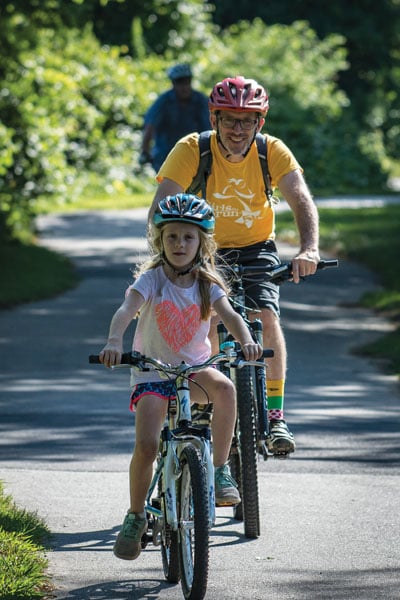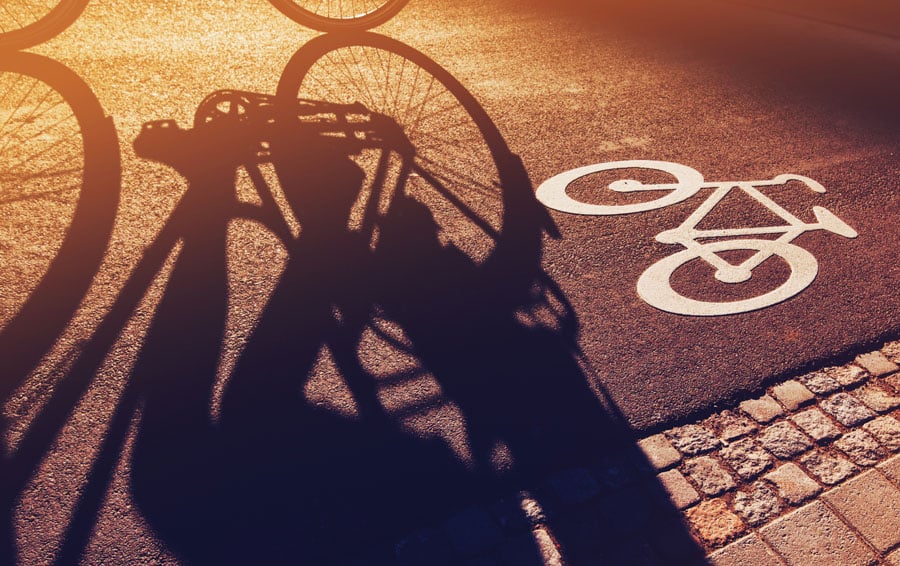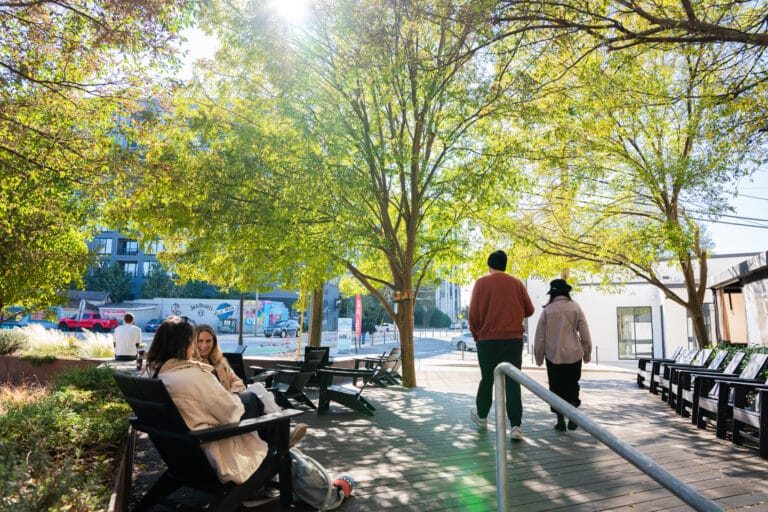Saturday, October 7, 2017. Hurricane Nate is wreaking havoc in the South. Forecasters predict the reckless cyclone will make its way to western North Carolina in a few days’ time, just the impetus 57-year-old Cullowhee, N.C., resident Jack Summers needs to go for a bike ride.
He sets out late that afternoon, following Tilley Creek Road down Cullowhee Mountain Road. With gravity on his side, he gains quickly on a truck up ahead, which pulls over and waves him by.
“They were very courteous,” he says. “I go a lot faster than automobile traffic on the downhills.”
Aside from the truck, Summers passes very few cars, a rare treat in the bustling community surrounding Western Carolina University where Summers teaches chemistry. He hangs a right at the intersection onto NC-107 and eases into the bike lane. It’s a short climb out of town, but Summers cranks up it in no time. Just as he begins to crest the top of the hill, he hears it, the most dreaded sound to cyclists everywhere, that of tires squealing on pavement.
“Next thing I know, I’m on the ground. I never lost consciousness. I thought about getting up and gave it a half-hearted try, but I felt something in my back, so I just laid there and waited for the ambulance to come to me.”
In a matter of minutes, an off-duty EMT and a young medical student are at his side, applying pressure to Summers’ back, which is bleeding profusely. One ambulance ride and a helicopter lift later, Summers was posted up in a bed at Mission Hospital in Asheville, N.C., alive, but badly injured. He had a compressed vertebra, a broken fibula, and a three-inch hole and Morel-Lavallée lesion the size of a cantaloupe on his back.
“I’m doing much better,” Summers tells me six weeks later in the comfort of his home. “I’m able to walk around without any kind of support. I feel like I was very lucky. I could have easily been killed at the scene of the accident. The people that stopped and helped me very likely saved me from bleeding to death right there,” and from being another number in a grim statistic.
Between 2000 and 2012, the number of cyclists in the U.S. commuting by bike increased by more than 250 percent. Reason would lead us to believe that as more bicycles take to the road, the more motorists become accustomed to their presence and, consequently, the less often collisions occur. But the trend is going in the opposite direction. In 2015, the U.S. Department of Transportation’s National Highway Traffic Safety Administration (NHTSA) found that 818 cyclists were killed in motor vehicle collisions, an increase of 12.2 percent from 2014. Like Summers, another 45,000 cyclists were injured in automobile-related crashes, which was not significantly different from the previous year’s estimated 50,000 injured.
Anecdotally, one need only browse the Internet to see that altercations of all degrees are on the rise between motorists and cyclists. Just a few days before an unlicensed and uninsured 24-year-old driver struck Jack Summers, Claude Donald Watson was caught on camera punching an Asheville-area cyclist in the face at a traffic light. A few months prior in Virginia’s Rockbridge County, a 14-year-old boy died after a 73-year-old woman made a left turn into him while he was riding his bike. And these are only a few that made 2017’s headlines.
“We took in three new cases this week,” says Ann Groninger, a personal injury attorney and co-founder of Bike Law, who specializes in representing injured cyclists, including the Asheville rider who received that on-camera punch-in-the-face. “Everyone who rides a bike on the road probably has had some experience like that,” whether it’s getting buzzed, or doored, or run off the road entirely. “Most drivers are probably tolerant [of cyclists], but there is a loud segment of drivers who aren’t and they’re the ones calling their legislators saying, ‘Get these bicycles off the road.’”
The problem for cyclists and motorists, whether or not they choose to believe it, is that legislators are listening and people are dying on our roads at a rate that is unacceptable.
The Public Health Crisis No One is Talking About
There are several factors that are contributing to the clash between cyclists and motorists. The economy is finally starting to recover, which means lower unemployment rates, more discretionary income, and more drivers. The year 2016 saw 3.2 trillion miles on the nation’s roads, which was up 2.8 percent from 2015. Traffic congestion that same year increased on average between 2 and 4 percent.
[nextpage title=”Read on!”]
Drivers are rightfully frustrated with all of that wasted time spent commuting in heavy traffic, but they’re also more distracted than ever, which is leading to more collisions. According to the NHTSA, distracted driving in 2015 led to 3,477 deaths, an increase of 8.8 percent from 2014. Distracted driving includes anything from texting while driving to using a navigation system or eating. Even responding to a text at a red light can lead to distraction for up to 27 seconds after responding to the message.
It was distraction, believes Jack Summers, that led to his hit-and-run incident last fall. “The fact that I heard the tires squealing, that to me suggests that it was not an intentional act,” he says.
Summers admits that he could have made himself more visible to the driver by using bike lights, but it was still full daylight at the time, there was perfect visibility, and he was riding in a designated bike lane. By all intents and purposes, Summers should have been safe, and that, says Bike Law founder Peter Wilborn, leads to one very important question.

“Why is it still wickedly unsafe to ride a bike? Everything else about safety in the last 20 years has improved. Cars have antilock brakes, we have better helmets. As more and more people ride, you would think the accident rate would go down, because that’s what it’s supposed to do, like death by cigarettes. At some point, with public awareness, smoking-related deaths plummeted. That’s what you would expect for cycling, but it’s not gotten safer. We have a public health crisis that has not been addressed.”
For the last 20 years, Wilborn has been at the frontlines of bicycle advocacy as a lawyer, activist, and cyclist. His passion for the cause is rooted in personal tragedy. In 1998, an underage driver ran a red light and collided with Wilborn’s 28-year-old brother Jim, who died instantly. Wilborn sought the legal aid of the most reputable lawyer in town, but was appalled at the lawyer’s initial reaction to the case.
“We were all crowded around a conference table beside ourselves with grief, and the first thing he said was, ‘Did Jim have a DUI?’ When we looked at him aghast, he said, ‘Why else would a 28-year-old man be on a bike?’ That moment changed my career.”
Wilborn started by representing injured cyclists in his home state of South Carolina. After joining ranks with affiliate lawyer and fellow cyclist Ann Groninger out of Charlotte, N.C., the team expanded into North Carolina and has now grown into Bike Law, a nationwide network of cyclist-lawyers representing injured cyclists in over 25 states and Canada.
At times, fighting for the cyclists’ cause feels like an uphill battle. Unfair and archaic legal doctrines like contributory negligence, which prevents recovery of damages for injured persons if they are found to be as little as 1 percent responsible for the collision that injures them, are still in existence in North Carolina, Virginia, Maryland, Alabama, and, until recently, the District of Columbia.
The difficulty of enforcing bicycle safety laws and adequately investigating bicycle-vehicle collisions further compounds the problem and pits motorists against cyclists. Drivers claim that cyclists don’t pay taxes, and therefore should not be allowed on the road, that they run stop signs and traffic lights, hog the lane, and split lanes. Cyclists, meanwhile, berate drivers for passing when it’s not safe, using vehicles as weapons of intimidation, seeding anti-bicycle sentiment among law enforcement and decision makers, and not giving the legally required three feet of space when overtaking cyclists.
[nextpage title=”Read on!”]
The truth, of course, lies somewhere in between. The vast majority of cyclists are also vehicle or property owners, which means they, too, pay the taxes that upkeep road infrastructure. Drivers, cyclists, and even pedestrians break traffic laws every day, from failing to use a turn signal to jaywalking across the street. While not always courteous, it is legal in 39 out of 50 states for cyclists to ride two abreast. And not all drivers are aggressive towards cyclists—some may simply be anxious.
But to Wilborn, all of this is superfluous.
“A war between bicycles and cars is frankly absurd,” he says. “It’s sandbox fighting. It’s this phony polarity that’s playing out in the national discourse, where everyone is either left or right. It gives them this self-righteousness of victim blaming that is intellectually dishonest. Why are cyclists being killed? It’s because policy makers have failed to understand transportation planning and plan accordingly. All of them, in every city, every county, every state, were caught completely flatfooted by the boom of people wanting to learn to bike or walk. There is no war. There is a lack of safe infrastructure which makes it likely that criminal drivers are going to kill cyclists at an alarming rate.”
The NHTSA’s statistics from 2015 support Wilborn’s argument. Of the 818 cyclists who died that year, 70 percent of those fatal crashes were in urban areas, 61 percent were not at intersections, and only 3 percent were in bike lanes. In 2014, the League of American Bicyclists dug deeper into the NHTSA’s data from 2011 to 2013, and similarly found that most fatalities occurred on high-speed “arterial” urban roads and that 40 percent of all cases were the result of a rear-end collision.
What if, Wilborn says, we did away with blaming crashes on one user group or the other and looked at the facts? What if we recognized that as cities grow, so too do their humble outskirts, which turns once quiet country-road-commutes into dangerous real-life rounds of Frogger? What if we elected leaders who prioritized alternative and safe transportation for all road users? What if we saw cyclists not as spandex-wearing elitists parading around on $10,000 bikes, but as working class citizens who use the bicycle not for recreation but for transportation? What if we saw cyclists as a solution to the problem, that if a mere 5 percent of drivers started taking public transportation or cycling to work, rush hour congestion could be reduced by 30 percent?
“It’s an easy straw man. People think it’s the cyclist slowing down traffic when cyclists are just the visual representation for a much bigger problem,” says Wilborn. “You have all of these drivers that are frustrated, and your initial reaction is not to blame yourself, or the other people doing the same thing as you. It’s to blame the guy that’s different.”
Cities Saving Lives
Chattanooga Police Department’s Rob Simmons has seen the contention between drivers and cyclists play out firsthand on the streets of downtown Chattanooga during his tenure on the city’s bike patrol. In 2009, the city’s cycling community took a devastating hit when one of its very own was killed after a large truck passed too close, snagging one of the rider’s saddle bags and throwing him from the bike.
The cyclist, 51-year-old David Leonard Meek, was a rule follower. He was dressed in reflective and fluorescent clothing, his bike sported flashing lights, and he was riding as far to the right as possible. Yet when Simmons read the crash report filed by the officer on duty, he was perplexed.
“The officer who wrote it stated that the vehicle could have seen the cyclist, but it’s not clear that he should have seen the cyclist. What he was saying was that even with the lights and the vest and the cyclist riding where he was supposed to, it wasn’t the fault of the driver. If you’re doing everything that the law requires you to do here in Tennessee, how is it not someone else’s fault? How is there no responsibility put anywhere?”
That fatality sparked a newfound sense of responsibility in Simmons that transcended his own passion for cycling. With the support of the police chief, Simmons launched the Chattanooga Safe Biking Initiative in 2015. His initiative had a three-pronged approach: educate motorists, educate cyclists, and enforce the three-foot passing rule by way of the C3FT, a bicycle-mounted device that can detect the exact proximity of passing vehicles.
Additionally, Simmons visited police departments throughout Tennessee and distributed an 11-page training manual on everything from how to properly investigate bicycle-vehicle collisions to listing specific cycling laws. The initiative was a tremendous success. Between 2015 and 2016, Chattanooga-area bicycle-vehicle crashes dropped 26 percent.
Coupled with Simmons’ Safe Biking Initiative, Chattanooga is one of the Southeast’s leaders in the Complete Streets movement, which provides safe access for pedestrians, bicyclists, motorists and transit riders. In the past seven years, the city has constructed 30 miles of separated greenways, one mile of protected bike lanes, 38 miles of bike lanes, and 37 routes with “share the road” signage. The Bike Chattanooga Transit System launched its bike share program five years ago, and already has 38 stations and 300 bikes scattered throughout the city.
Chattanooga’s Assistant City Traffic Engineer Ben Taylor says the increased bike infrastructure has been met with some skepticism, but that the implementation of bike lanes helps solve other problems such as speeding and parking.
[nextpage title=”Read on!”]
“Business owners might complain and say that no one really bikes down their way, but those same folks have complained about high traffic speeds and are in an area that has three new restaurants and apartment complexes being built. We’re turning a four-lane to one lane each way with a parking lane and a bike lane, which still serves the driving public by helping calm traffic.”
The increased bike lanes are also good for business, as any number of economic impact studies can attest. The Swamp Rabbit Trail in Greenville, S.C, for example, injects close to $7 million annually. Local and non-local visitors to the Virginia Creeper Trail in Damascus and Abingdon, Va., spend more than $2.5 million in the region, supporting a host of restaurants and lodging facilities.
A 2013 study conducted by the North Carolina Department of Transportation (NCDOT) estimated that upgrades in bicycle and pedestrian infrastructure could even reduce health care costs by as much as $76 million while providing a one-time property value increase of $64 million. The investment seems like a no-brainer, yet many bike infrastructure projects have stalled in recent years. Last October, North Carolina was among a number of states that returned close to $4 million in Transportation Alternatives Program (TAP) funding designated specifically for pedestrian and bicycle infrastructure.
“If we are serious and we are committed to public safety, then that money should have been spent,” says Asheville On Bikes Executive Director Mike Sule.
It’s no secret that the southern metropolis is booming with mountain biking and road cycling tourism. The city was recently selected as the only East Coast destination to host the prestigious three-day Haute Route, an international cycling event expected to generate more than $1 million in the western North Carolina region.
“The growth of cycling is way more than the infrastructure development that needs to happen,” says Cane Creek Cycling Components Retail Services Coordinator Bryan Flack. “If we want to be the progressive town that we like to think we are and I know we want to be, let’s see some pedestrian and cycling infrastructure.”
But according to Ed Johnson of the NCDOT Division of Bicycle and Pedestrian Transportation, sometimes, spending that federal money is harder than it seems. Though NCDOT has awarded over $5 million in grant money for infrastructure since the inception of its Planning Grant Initiative in 2004, there are two caveats to securing that funding: municipalities must submit a publically vetted plan and they must be ready to match 20% of NCDOT’s funding.
“That becomes a real hurdle for some of the smaller, rural communities where 20% is a considerable amount of money,” says Johnson. “When it came to the so-called ‘return’ of the TAP funding, many of the municipalities that were to receive that funding were not in a position as of yet to be able to spend it. State funds cannot be used for matching the federal money by statute.”
Municipalities can get creative, though, says Johnson, and many North Carolina communities have been able to achieve that 20% match through support from Land and Water Conservation Fund, Clean Water Management Trust Fund, Parks and Recreation Trust Fund, or even private sectors and county health departments. The process can be tedious and time-consuming, and if a municipality has not already established that publically vetted plan, it could run out of time to nab those funds.
Though the cost of constructing big projects like greenway systems ($1 million per mile, on average) is often cited as a hindrance to increasing bicycle friendly facilities, Roanoke’s Transportation Division Manager Mark Jamison begs to differ. Though Roanoke is well-loved for its extensive greenways, Jamison says the city has spent the past 15 years knocking out what he calls the low-hanging fruit of the transportation world: repaving and repainting.
“It’s not something we had to spend a lot of money doing because we were just reallocating existing space instead of creating new space,” says Jamison. “The only thing we’re adding is a paint stripe, and you’re talking about pennies a foot. You’re spending hundreds of dollars, not thousands of dollars, so I don’t track [the expense] because it’s not expensive.”
Roanoke is now charged with tackling bigger projects that will require more funds, but Jamison says that cities everywhere should be repaving, repainting, and reallocating space to accommodate all road users, not just motorists, starting now, even if it means making a bike lane that continues for only a mile before dead-ending.
“We have to look more to what we want our cities to be like in the future,” he says. “If you don’t add something when you can, you might not ever add it, and even if a bike lane doesn’t connect to something today, years from now, there might be an opportunity to connect it. Be confident in that.”
Back in Cullowhee, N.C., Jack Summers is a staunch supporter of bike lanes, and attests the presence of the bike lane he was riding in to surviving the crash. Having ridden on Jackson County’s roads for almost 15 years without incident, Summers says he almost feels safer on winding country roads than the fast-and-straight four-lane highways.
“It’s counterintuitive, I know, but that’s how it is. People have to pay attention then.”
He’s not bitter or angry toward the young driver who hit him, and who is presently sitting in jail awaiting charges ranging from a felony hit-and-run to making a false statement to a cop and driving without a license.
“It doesn’t help anything to be angry,” says Summers. “You’re playing the odds anytime you get in a vehicle, whether it’s a car or a bike or a motorcycle or even walking down the sidewalk.”
The unfortunate reality, says Rob Simmons of the Chattanooga Police Department, is that the odds are rarely in favor of the cyclist.
“It doesn’t matter if it’s the cyclist’s fault or the motorist’s fault. Whenever a vehicle and a cyclist collide, there is only one loser. The cyclist always loses. If we can show a little humanity, and realize that cyclists are humans too with mothers, fathers, children, spouses, it could go a long way toward preserving life in the end.”








